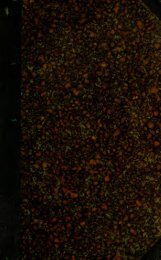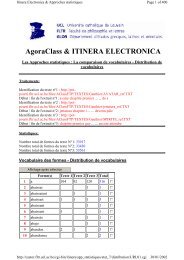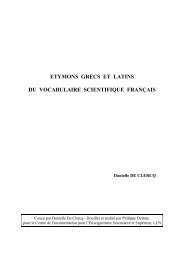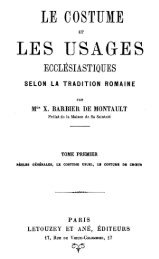The Etymologies of Isidore of Seville - Pot-pourri
The Etymologies of Isidore of Seville - Pot-pourri
The Etymologies of Isidore of Seville - Pot-pourri
You also want an ePaper? Increase the reach of your titles
YUMPU automatically turns print PDFs into web optimized ePapers that Google loves.
‘entire’ is called . <strong>The</strong>cycnus (i.e. cygnus, another<br />
word for swan, borrowed,infact,from the Greek <br />
just cited) is named for singing (canere)because it pours<br />
out a sweetness <strong>of</strong> song with its modulated voice. It is<br />
thought to sing sweetly because it has a long curved neck,<br />
and a voice forcing its way by a long and winding path<br />
necessarily renders varied modulations. 19. People say<br />
that in the Hyperborean regions, when musicians are<br />
singing to citharas, swans come flocking in large numbers,<br />
and sing with them quite harmoniously. Olor is the<br />
Latin name, for in Greek they are called . Sailors<br />
say that this bird makes a good omen for them, just as<br />
Aemilius (Macer) says (fr. 4):<br />
<strong>The</strong> swan is always the most fortunate bird in omens.<br />
Sailors prefer this one, because it does not immerse itself<br />
in the waves. 23<br />
20.<strong>The</strong>ostrich(struthio)isnamedwithaGreekterm;<br />
this animal is seen to have feathers like a bird, but it does<br />
not rise above the ground. It neglects to incubate its eggs,<br />
but the abandoned eggs are brought to life by the warmth<br />
the earth alone. 21.<strong>The</strong>heron(ardea)isnamed as if the<br />
word were ardua (i.e. “steep”) – this is on account <strong>of</strong> its<br />
l<strong>of</strong>ty flight. Lucan (Civil War 5.553)says:<br />
And that the heron dared to fly.<br />
It is afraid <strong>of</strong> rainstorms, and flies above the clouds so<br />
that it cannot feel the storms in the clouds, and whenever<br />
it flies higher, this indicates a storm. Many people call it<br />
the tantulus. 22.<strong>The</strong>phoenix(phoenix)isabird<strong>of</strong>Arabia,<br />
so called because it possesses a scarlet (phoeniceus)<br />
color, or because it is singular and unique in the entire<br />
world, for the Arabs say phoenix for ‘singular.’ This bird<br />
lives more than five hundred years, and when it sees that<br />
it has grown old it constructs a funeral pile for itself <strong>of</strong><br />
aromatic twigs it has collected, and, turned to the rays<br />
23 <strong>Isidore</strong>’s source for Macer’s lines, Servius’s commentary on<br />
Aen. 1.393,originally read “is never immersed” for “does not immerse<br />
itself.” Because swans are never overwhelmed by waves, they are an<br />
omen <strong>of</strong> good weather.<br />
24 Lindsay emended the early manuscript readings, strophalides,<br />
etc., and strophades,etc.<strong>The</strong> Strophalides are legendary bird-women,<br />
the Harpies, who lived on the Strophades, islands <strong>of</strong>f the coast<br />
<strong>of</strong> Messinia. <strong>The</strong> stymphalides are the loathsome raptors slain by<br />
Hercules.<br />
25 AGreek king and warrior in the Trojan War who emigrated to<br />
Apulia.<br />
<strong>The</strong> <strong>Etymologies</strong> XII.vii.19–vii.28 265<br />
<strong>of</strong> the sun, with a beating <strong>of</strong> its wings it deliberately kindles<br />
a fire for itself, and thus it rises again from its own<br />
ashes.<br />
23. <strong>The</strong>cinnamolgus is also a bird <strong>of</strong> Arabia, called<br />
thus because in tall trees it constructs nests out <strong>of</strong> cinnamon<br />
(cinnamum) shrubs, and since humans are unable<br />
to climb up there due to the height and fragility <strong>of</strong> the<br />
branches, they go after the nests using lead-weighted<br />
missiles. Thus they dislodge these cinnamon nests and<br />
sell them at very high prices, for merchants value cinnamon<br />
more than other spices. 24. <strong>The</strong>parrot (psittacus)<br />
comes from the shores <strong>of</strong> India. It is green in color, with a<br />
scarlet collar and a large tongue, wider than that <strong>of</strong> other<br />
birds. Hence it pronounces articulate words so that if<br />
you did not see the bird you would think a human was<br />
speaking. It makes a greeting naturally, saying “Have!”<br />
(i.e. Ave,aLatin greeting) or “!” (i.e. a Greek greeting).<br />
Other words it learns by being taught. Hence it is<br />
spoken <strong>of</strong> (Martial, Epigrams 14.73):<br />
I, a parrot, would learn from you the names <strong>of</strong> others,<br />
but on my own I have learned to say this:<br />
“Hail (Have), Caesar!”<br />
25.<strong>The</strong>alcyon (i.e. “halcyon,” in classical Latin, “kingfisher”),<br />
a sea bird, is named as if the word were ales<br />
oceana (ocean bird), because in winter it makes its nest<br />
and raises its young on still waters in the Ocean. It is said<br />
that when they are brooding on its expansive surface,<br />
the sea grows calm with the winds silent in continuous<br />
tranquillity for seven days, and nature herself cooperates<br />
in the rearing <strong>of</strong> their young. 26.<strong>The</strong>pelican (pelicanus)<br />
is an Egyptian bird inhabiting the solitary places <strong>of</strong> the<br />
river Nile, whence it takes its name, for Egypt is called<br />
Canopos. Itisreported, if it may be true, that this bird<br />
kills its <strong>of</strong>fspring, mourns them for three days, and finally<br />
wounds itself and revives its children by sprinkling them<br />
with its own blood.<br />
27.<strong>The</strong>stymphalis is a bird named from the islands <strong>of</strong><br />
Stymphades (cf. Stymphales, a lake in Arcadia), where<br />
they are abundant; Hercules used arrows against them. 24<br />
<strong>The</strong>y are sea birds living on islands. 28. Diomediae are<br />
birds named from the companions <strong>of</strong> Diomedes; 25 fables<br />
say that his companions were transformed into these<br />
very birds. <strong>The</strong>y are similar to coots in shape, the size<br />
<strong>of</strong> a swan, white in color, with large hard beaks. <strong>The</strong>y<br />
are found near Apulia on the island Diomedia, flying<br />
between the crags <strong>of</strong> the shore and the rocks. <strong>The</strong>y

















